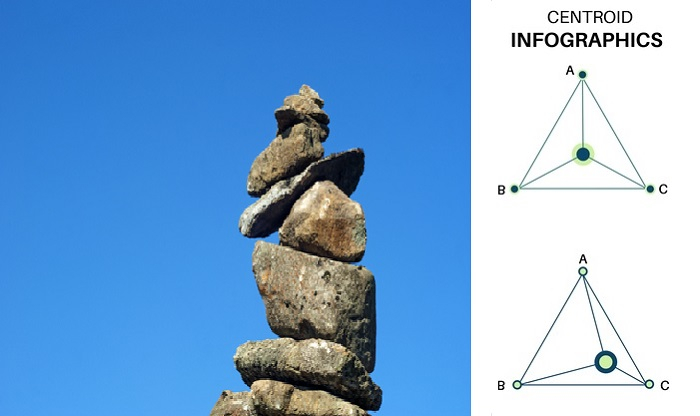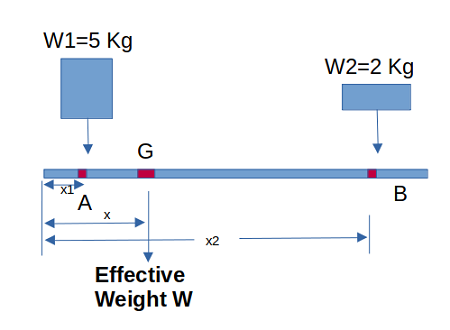Introduction
Centroid is the term that applies to a geometrically balanced figure or an object. It is the center of that figure or object. The methods to find the center of a symmetrical entity differs, but it exists, and there is no confusion about that.
For example, a triangle has the centroid which is the meeting point of three medians. In contrast to the centroid, the center of gravity is a broader term that encompasses symmetrical and asymmetrical objects and figures. It is interesting to note that the center of gravity and the centroid are the same for a symmetrical object as well as volumetric figures and shapes. For asymmetrical objects, we need to do a weightdistance analysis and find the average by dividing it by the total weight to find the distance of COG. The figure below gives an idea of how we can perceive both these concepts

Fig:1 Centre of gravity of irregular stones and the Centroid of Trapezium
The Centre of gravity and centroid tend to be the same for two-dimensional figures and volumetric figures and is important to know because of the stability and balance it provides. In the above figure, the center of gravity of irregular stones will shift to the left due to the tilt presented while arranging them one by one and due to the irregular shapes of the stones. In the case of trapezium, the formula is given in the figure once you have a, b and h. This article gives clarity to the concept of the center of gravity and centroid. Both of them are very closely related terms in terms of centering or stability of a volume or mass object but differ under certain circumstances.
Centre of Gravity (COG)
The Centre of gravity is the imaginary point in an object through which the earth’s gravitational force acts on the material mass of an object to create its weight. It is at that point the entire weight is focused to provide the required stability for that object.
The equation Weight = Mass ×× Gravitational Force;W = mg is worth mentioning here. The center of gravity is the distance from a reference point on the object. So the unit by which it is measured is in meters.
The importance of the center of gravity is well understood if you take the example of the stability of automobiles. Cars, trucks, and vehicles have a very strict design phase where the manufacturers test the COG of the vehicle to be as low as possible when satisfying all other requirements. The lower the COG is; the better stability is for the vehicle on road.
Explore our latest online courses and learn new skills at your own pace. Enroll and become a certified expert to boost your career.
Equation for Centre of Gravity
Referring to the figure below, the rod is having two weights at two ends – W1(5kg) acting at point A and W2(2kg) acting at point B. With this weight distribution, the center of gravity is acting at point G.

Fig:2 Find the center of gravity
With x1 and x2 distances marked in the figure, the equation for distance x (COG) will be
x=(x1W1+x2W2)(W1+W2)x=(x1W1+x2W2)(W1+W2)
Relation between Centre of Gravity (COG) and Centre of Mass (COM)
The Centre of gravity is an imaginary point in the object where the weight of the object acts downward due to the effect of the earth’s gravitational force. The Centre of mass is the point in the object matter, where external force acting in the object would make its effect of moving in the direction intended by the external force.
No other factors other than the intended direction are connected with the point identified as the center of mass. In many scenarios, both of these would converge to the same point. But both are not the same always. COG acts downward due to gravity, while in contrast, COM acts in the intended direction of external force.
Leave a Reply